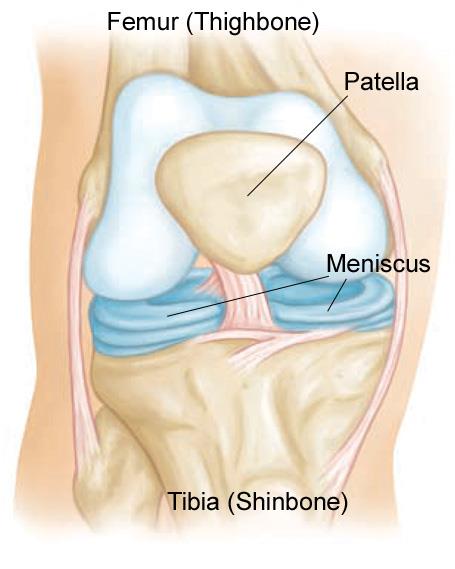Dr. Tauro is a nationally recognized innovator in orthopedic care for surgical and non-surgical musculoskeletal problems.

Normal knee anatomy. Photo courtesy: OrthoInfo.org
TOMS RIVER, N.J. – March 2, 2022 – PRLog — Knee meniscal surgeries are one of the most common performed by orthopedic surgeons. Dr. Tauro uses his expertise to help shed light on meniscal injuries and treatment options through this informative Q&A session.
Q: What is the meniscus?
Dr. Tauro: There are two menisci in a knee – the medial meniscus and the lateral meniscus, corresponding to their location either on the inside or outside of the knee. They are crescent-shaped bands of thick, rubbery tissue attached to the tibia. The meniscus acts as a shock absorber inside the knee as well as matching the relatively flat surface of the tibia to the curved surface of the femur. If the meniscus is damaged, its function as a shock absorber is damaged. Increased force leads to breakdown of the articular cartilage surfaces of the joint. Therefore, we try to preserve the function of the meniscus as much as possible. The more meniscus you have, the more shock absorption you will benefit from and the less chance you will develop arthritis in the future.
Q: How do you tear a meniscus?
Dr. Tauro: You can tear a meniscus through a traumatic or sports injury, as well as more chronic wear and tear. Most meniscal injuries are post-traumatic in younger patients, or part of an overall degenerative process in older patients. Younger persons who have articular surface damage are candidates for cartilage repair or replacement grafting. Older patients with more diffuse cartilage breakdown (we all call this arthritis), are not good candidates for cartilage grafting and may not do well after meniscal surgery. These patients may do better with gel or PRP injections and ultimately may require joint replacement.
Q: Do all meniscal tears require surgery?
Dr. Tauro: Small tears (without a mechanical block to the knee) will typically benefit over time with physical therapy. Bigger tears (vertical or horizontal) often cause persistent symptoms and more inflammation. These are the types of tears that require more urgent treatment that involves surgery.
Q: Is it ever recommended to perform surgery on a patient who has a meniscal tear because of arthritis?
Dr. Tauro: Surgery is only recommended when an individual has a tear that is so large that it causes a mechanical block.
Q: What does meniscal surgery do?
Dr. Tauro: When a portion of the meniscus is irreparable, we literally take that part out and sew the other part. If you can repair the meniscus in a younger patient, the more meniscus you can save and the less chance a person will get arthritis in the future. Meniscal transplantation is a very effective treatment for younger patients who have irreparable tears, failed meniscal repairs or have lost a large part of their meniscus from multiple injuries.
Q: What is recovery like for knee surgery?
Dr. Tauro: An arthroscopic meniscal surgery takes approximately 30 minutes to perform, and the rehab is immediate with very little post-operative pain. After a routine knee arthroscopy, your knee is 100 percent in typically three months. A meniscal repair takes about four months to heal and six months to play contact sports.
Q: Why does it take longer for a meniscal repair to heal post-operatively?
Dr. Tauro: The meniscus has a poor blood supply and takes a long time to heal. Approximately 20 percent of meniscal repairs fail due to the poor blood supply to the meniscus.
Q: What’s on the horizon for advancements in meniscal repair?
Dr. Tauro: We are doing additional research on biologics, and, specifically, Bone Marrow Derived Stem Cells. This is where we take about 60 ccs of bone marrow and put it through a separate machine that retrieves 5-7 ccs of stems cells. We inject these stem cells into the area around the meniscal repair. It does not accelerate healing, but we have found that it does enable increased healing response and less recurrence.
About Ocean County Sports Medicine
Ocean County Sports Medicine, a comprehensive, regional orthopedic practice located at 9 Hospital Drive in Toms River, NJ, was established in 1988 by Dr. Joseph C. Tauro, a nationally recognized innovator in orthopedic care for surgical and non-surgical musculoskeletal problems. To learn more or to schedule an appointment with Dr. Tauro, please visit https://oceancountysportsmedicine.com/
About Dr. Joseph C. Tauro, MD
Dr. Joseph C. Tauro, MD has traveled extensively both nationally and internationally to teach advanced surgical techniques to other doctors. He is a member of the Board of Directors of AANA(the Arthroscopy Association of North America), a national and international organization for the advancement of orthopedic surgery in the United States and in 80 countries globally. Dr. Tauro currently leads Ocean County Sports Medicine. He is also a Clinical Professor of Orthopedic Surgery at Rutgers New Jersey Medical School in Newark, NJ.
